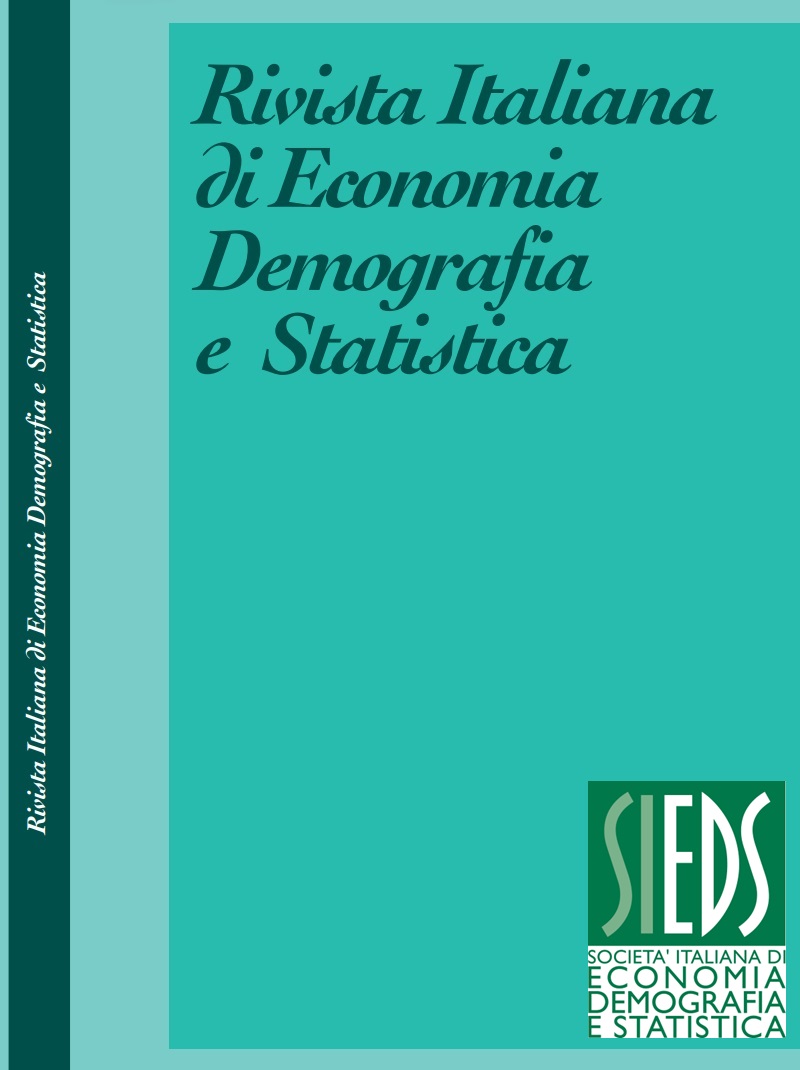Multiversal model of measurement of a composite index of well-being
DOI:
https://doi.org/10.71014/sieds.v79i3.284Keywords:
Multiverse Analysis, Composite index, Sustainaible well-being, clustering, rankingAbstract
The aggregation of many indicators into a unique index may hide the latent uncertainty in the rank orders of the statistical units due to the freedom in the choice of the aggregating methods. Multiversal modelling enhance this flexibility in the operative definition to derive a posterior distribution of estimates for the latent composite index. This study applies this principle to map the distribution of quality of life in 107 provinces in Italy.
References
ALAIMO L.S., MAGGINO F. 2020. Sustainable Development Goals Indicators at Territorial Level: Conceptual and Methodological Issues—The Italian Perspective, Social Indicators Research, Vol. 147, No. 2, pp. 383–419. DOI: https://doi.org/10.1007/s11205-019-02162-4
CANTONE G.G., TOMASELLI V. 2024. Characterisation and Calibration of Multiversal Methods, Advances in Data Analysis and Classification, 10.1007/s11634-024-00610-9. DOI: https://doi.org/10.1007/s11634-024-00610-9
COLTMAN T., DEVINNEY T.M., MIDGLEY D.F., VENAIK S. 2008. Formative versus reflective measurement models: Two applications of formative measurement, Journal of Business Research, Vol. 61, No. 12, pp. 1250–1262. DOI: https://doi.org/10.1016/j.jbusres.2008.01.013
DE CARVALHO M. 2016. Mean, What do You Mean? The American Statistician, Vol. 70, No. 3, pp. 270–274. DOI: https://doi.org/10.1080/00031305.2016.1148632
GRECO S., ISHIZAKA A., TASIOU M., TORRISI G. 2019. On the Methodological Framework of Composite Indices: A Review of the Issues of Weighting, Aggregation, and Robustness, Social Indicators Research, Vol. 141, No. 1, pp. 61–94. DOI: https://doi.org/10.1007/s11205-017-1832-9
LEIBEL C., BORNMANN L. 2024. Specification uncertainty: What the disruption index tells us about the (hidden) multiverse of bibliometric indicators. Scientometrics. https://doi.org/10.1007/s11192-024-05201-1. DOI: https://doi.org/10.1007/s11192-024-05201-1
MAZZIOTTA M., PARETO A. 2013. Methods for constructing composite indices: one for all or all for one? Italian Journal of Economic, Demographic and Statistical Studies - Rivista Italiana Di Economia Demografia e Statistica, Vol. LXVII, No 2.
MUNDA G. 2022. Qualitative reasoning or quantitative aggregation rules for impact assessment of policy options? A multiple criteria framework, Quality & Quantity, Vol. 56, No. 5, pp. 3259–3277. DOI: https://doi.org/10.1007/s11135-021-01267-8
MUNDA G., MATARAZZO A. 2020. On the impossibility of using “the correct” cost–benefit aggregation rule, Journal of Economic Studies, Vol. 47, No. 5, pp. 1119–1136. DOI: https://doi.org/10.1108/JES-06-2019-0269
MUNDA G., NARDO M. 2009. Noncompensatory/nonlinear composite indicators for ranking countries: A defensible setting, Applied Economics, Vol. 41, No. 12, pp. 1513–1523. DOI: https://doi.org/10.1080/00036840601019364
PARUOLO P., SAISANA M., SALTELLI A. 2013. Ratings and Rankings: Voodoo or Science? Journal of the Royal Statistical Society Series A: Statistics in Society, Vol. 176, No. 3, pp. 609–634. DOI: https://doi.org/10.1111/j.1467-985X.2012.01059.x
PATRIZII V., PETTINI A., RESCE G. 2017. The Cost of Well-Being, Social Indicators Research, Vol. 133, No. 3, pp. 985–1010. DOI: https://doi.org/10.1007/s11205-016-1394-2
PERMANYER, I. 2012. Uncertainty and robustness in composite indices rankings. Oxford Economic Papers, Vol. 64, No. 1, pp. 57–79. DOI: https://doi.org/10.1093/oep/gpr018
Downloads
Published
Issue
Section
License
Copyright (c) 2025 Giulio Giacomo Cantone

This work is licensed under a Creative Commons Attribution 4.0 International License.



